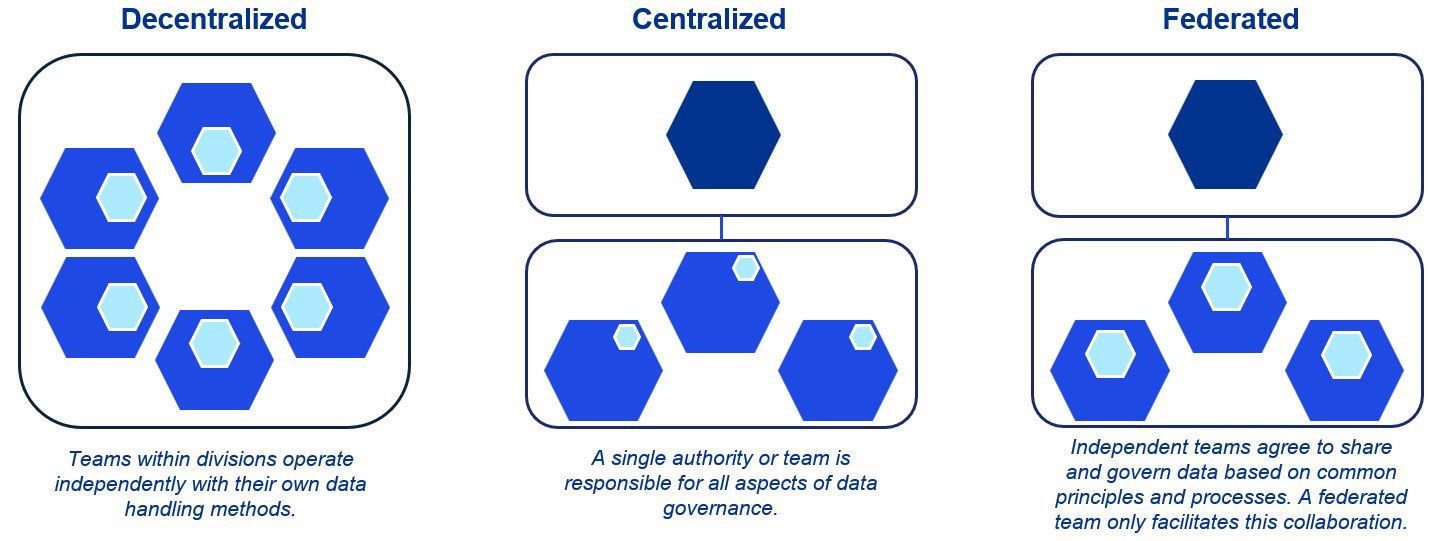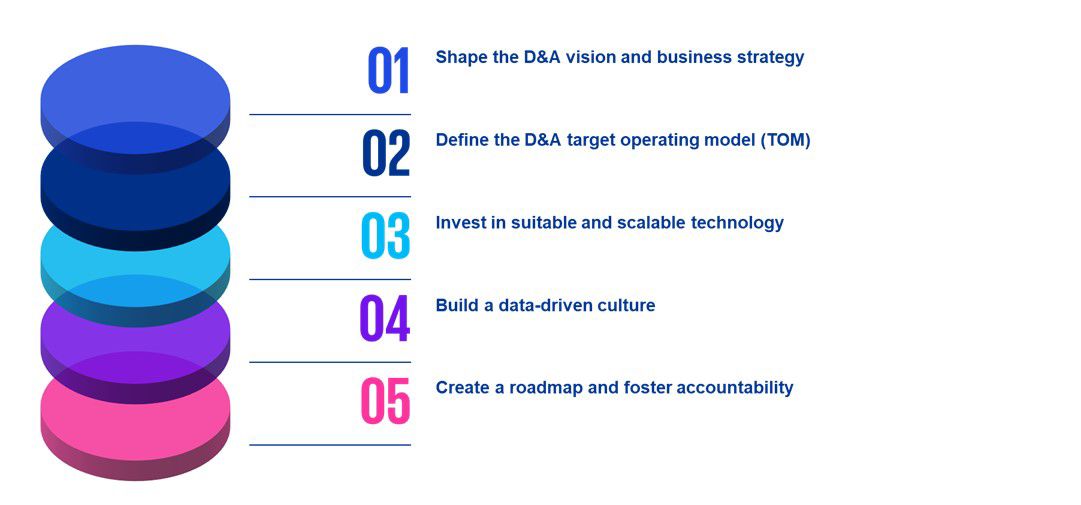In a rapidly developing environment where transformative technologies such as generative AI are having an enormous impact on business and society, it is important for organizations to harness the power of data and analytics. With growing data volumes and variety, efficiently scaling data infrastructure and innovating analytics tools are crucial to managing diverse datasets and deriving valuable insights. Being a data-driven organization is therefore no longer a mere advantage but a necessity to keep up with today's fast-paced business world and stay ahead of the competition. A KPMG survey of C-level executives found that only 32% of them fully utilize their customer data, while 75% of them believe that using enterprise data effectively can radically change their business models (KPMG, 2023).
In this series of articles, we will explain the importance of a business-focused data and analytics (D&A) strategy, resulting in a focused build-up and development of the right capabilities. Every business is inherently a data business and therefore a D&A strategy is essential for all organizations to unlock their potential and create value. We will explore the key elements of achieving an ideal D&A strategy and how they form the foundation for a data-driven organization. We will also delve into how to shape and implement a D&A strategy to achieve your desired data and AI ambitions. These AI ambitions will be explored further by highlighting essential components for an impactful AI strategy.
We will start this series of articles by introducing the importance of a well-defined D&A strategy for every organization. Afterward, we will explain how this D&A strategy should be seamlessly integrated into a broader business strategy to achieve the intended ambitions, and lastly we will dive into the fundamental components of a D&A strategy.
Understanding D&A
A data and analytics (D&A) strategy is a comprehensive plan which outlines how an organization will leverage data to achieve its strategic goals and drive business outcomes. It is rooted in and built upon the business strategy, aligning with the long-term business goals and dealing with the ’why’ of data. A D&A strategy focuses on enabling the business to make informed decisions and achieve sustainable growth. It serves as the guiding force for leveraging data assets and organizes analytics efforts to maximize business impact and competitive advantage.
Why every organization needs a well-defined D&A strategy
At the core of any successful organization lies an effective business strategy. Data plays a crucial role in making such a business strategy effective, as it is deeply dependent on data. This is because most, if not all, of the goals outlined in an effective business strategy are heavily reliant on data analysis and data interpretation. As a result, a well-defined D&A strategy is crucial to the business strategy and the organization. It ensures that enormous amounts of data are transformed into clear and useful insights, which can then be used by the organization as a guide for making decisions in a more planned and forward-thinking way, rather than just reacting to situations as they happen or relying solely on ‘gut feeling’.
With a set D&A strategy, organizations can:
- make informed decisions that can lead to cost efficiencies;
- build revenue through new products or markets; and
- be compliant in a more effective and efficient way.
A D&A strategy plays an important role in cost efficiency by enabling organizations to make data-driven decisions that streamline operations and reduce financial waste. Through analysis of data, organizations can pinpoint inefficiencies and cut costs that are unnecessary. Also, by predicting future trends and optimizing resource allocation, a D&A strategy ensures that all the financial resources that are spent contribute directly to the company's bottom line, driving down costs while maintaining high operational standards.
Being able to quickly recognize changes in the market is crucial as it allows organizations to promptly adjust and capitalize on new opportunities, a factor that can significantly impact an organization's future positioning as either a market leader or a laggard. A well-defined D&A strategy provides the necessary input for organizations to recognize these market changes and respond to them effectively within their business strategy. For instance, consider a company that sells smartphones. By establishing a strong D&A strategy, the company can leverage AI to analyze, for example, social media sentiment. This D&A- and AI-driven approach can enable the company to forecast the number of incoming orders for a new smartphone model, allowing proactive adjustments to orders with their supplier to match the forecasted demand. This proactive approach is far more effective than relying solely on historical sales data from previous models, which may not accurately reflect current market trends.
Furthermore, a D&A strategy helps companies stay compliant with rules and regulations in a cost-effective manner. By leveraging D&A, organizations can automate compliance processes, reduce human errors and ensure compliancy with regulations. D&A also enables proactive identification of compliance risks, potentially saving organizations from costly penalties and reputational harm. Additionally, D&A can simplify the tracking and reporting requirements imposed by regulators, making compliance management more efficient and less resource-intensive.
Lastly, with the rise of generative AI and its importance to organizations, having a well-defined D&A strategy has become more important than ever. AI depends on high-quality, well-integrated and secure data to operate efficiently. Therefore, having a strong D&A strategy is key to the success of an organization's AI implementation. This will be further explored in the third article of this series.
Exploring the elements of a D&A strategy
There are several essential components for a successful D&A strategy, which play a crucial role for effectively managing and utilizing data within the organization. Each of these components is related to the organization’s vision, its people and its digital infrastructure, as described below:
The D&A vision is shaped by the business strategy
The D&A strategy is related to the business strategy of an organization. D&A initiatives should serve clear business outcomes and support the defined business strategy of the organization. The first step is to define a D&A vision in which the D&A implications of the business strategy are summarized. The D&A vision provides a compelling narrative for stakeholders across the organization, who are more likely to embrace the D&A strategy when it directly contributes to measurable outcomes, fostering buy-in and enthusiasm and providing focus in defining the required activities.
Define D&A target operating model (TOM)
The D&A target operating model entails the capabilities needed (e.g. governance, processes, tooling) and how to organize them. The data organization's operating model should align with and support the business's operating model. Opting for a federated, centralized or decentralized model is a choice that must reflect the organization’s culture and business model to facilitate adoption.

Figure 1: Business operating model structure
A key component of the TOM is the D&A governance framework, which outlines the key elements for control and management of data and analytics, including the structure and setup for managing data and analytics, the roles and responsibilities, and the meeting structures. Data governance addresses the 'who', 'when' and 'where' of D&A, defining the roles of those involved in ensuring the right access to specific data at the right time and in the right format.
Furthermore, defining an analytics delivery model is important to organize and manage the analysis of an organization's data. The organization needs to consider which skills and tools are needed for employees to effectively analyze data in a self-service manner and whether advanced analytics is performed in-house by a team of data specialists or outsourced, and how the organization can, in strong collaboration with data specialists, connect the data with the business to derive the maximum value from it.
Invest in suitable and scalable technology
Technology choices are a key part of the design of the D&A strategy. The future data architecture of the organization should address short- and long-term needs while remaining flexible and scalable when making strategic choices on data management tooling and technology which will enable the data and analytics ambitions. The technology choices can vary from focused data management tooling to improve data governance and data quality up to cloud-based data platforms to facilitate data integration and possible data ecosystems within or outside the organization.
Build a data-driven culture
To unlock the potential of data, leaders and managers should focus not only on an organization being 'data aware', but also on being 'data-driven'. With 72% of the Chief Data Officers (CDOs) seeking to establish a data-driven culture and literacy as long-term strategic objectives of their D&A strategy (KPMG, 20231), the importance of a data-driven culture is widely acknowledged. Building a data-driven culture involves creating an environment where decisions are based on data rather than intuitions and where every employee has a general understanding of data literacy. For more information about data culture and data literacy, please refer to our article series written on this subject.
Create a suitable roadmap and foster accountability
To ensure the successful development and implementation of a D&A strategy, certain factors need to be considered. First, it is essential that top management demonstrates commitment and sponsorship to derive value from data and implement it across the organization. Given that 59% of CDOs have difficulty securing proper funding for data initiatives and 7% fail to meet the expectations (KPMG, 2023), obtaining management buy-in is crucial for the success of a D&A strategy. Additionally, it is essential to identify, engage and co-develop with all relevant stakeholders to secure their support and clarify what a D&A strategy will mean for them. Finally, the goal is to develop a realistic and actionable plan that aligns with the organization's ambitions and the value they aim to create from their D&A strategy.

Figure 2: Elements of a D&A strategy
Wrapping up
In conclusion, a well-defined data and analytics (D&A) strategy is vital for organizations to harness the full potential of their data, drive informed decisions and maintain a competitive edge in today's rapidly evolving business environment. By aligning data initiatives with business goals, focusing on governance and building a data-driven culture, organizations can unlock significant value and increase cost efficiencies, strengthen decision-making and maintain regulatory compliance. However, for a D&A strategy to truly succeed, it must be supported by solid data management foundations, which ensures data is accurate, accessible and secure across its entire lifecycle.
In our next article, we will dive deeper into the critical role of data management, exploring why it serves as the foundation for an effective D&A strategy. We will explain how data management is built and how it enables organizations to get meaningful insights and drive AI ambitions using actual use case examples.


